文章目录
求一键三连
希望大家看完觉得有用的话点赞、关注和收藏,感谢!!!
前言
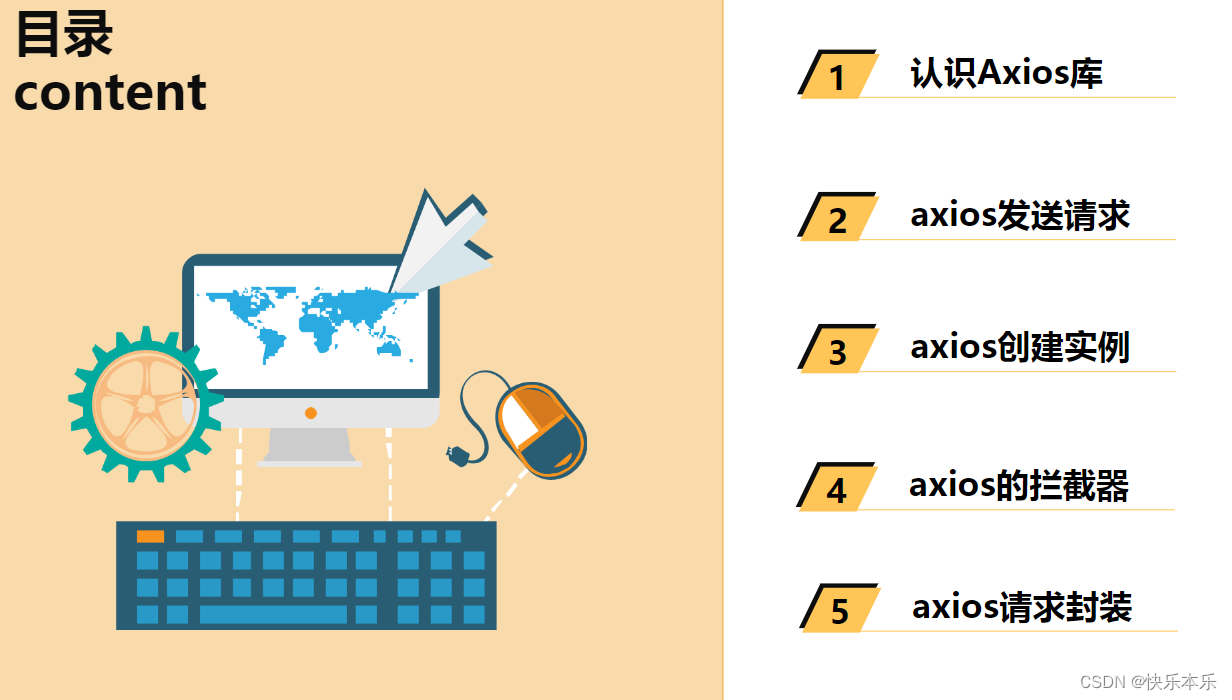
axios可以在浏览器和node里面用
原生的问题:无法在node里使用,fetch是在浏览器里使用的。(但是原生可以帮助我们理解。)
认识axios
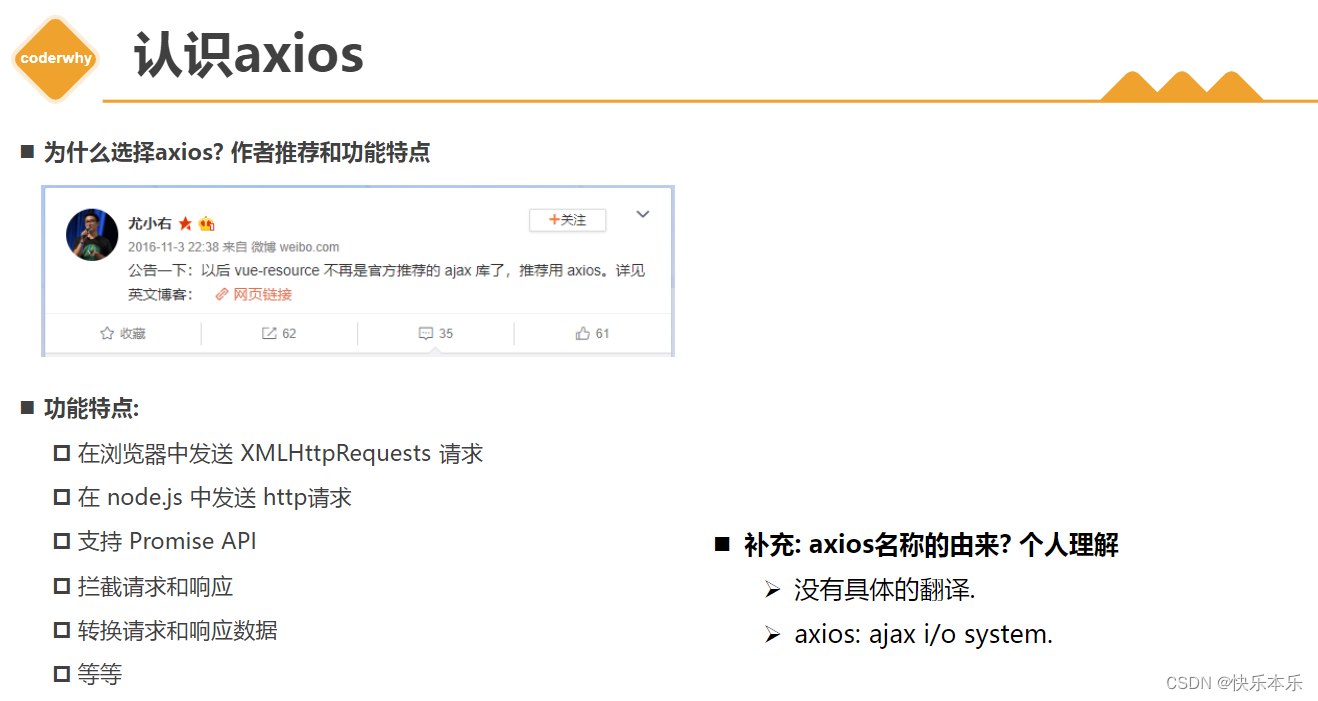
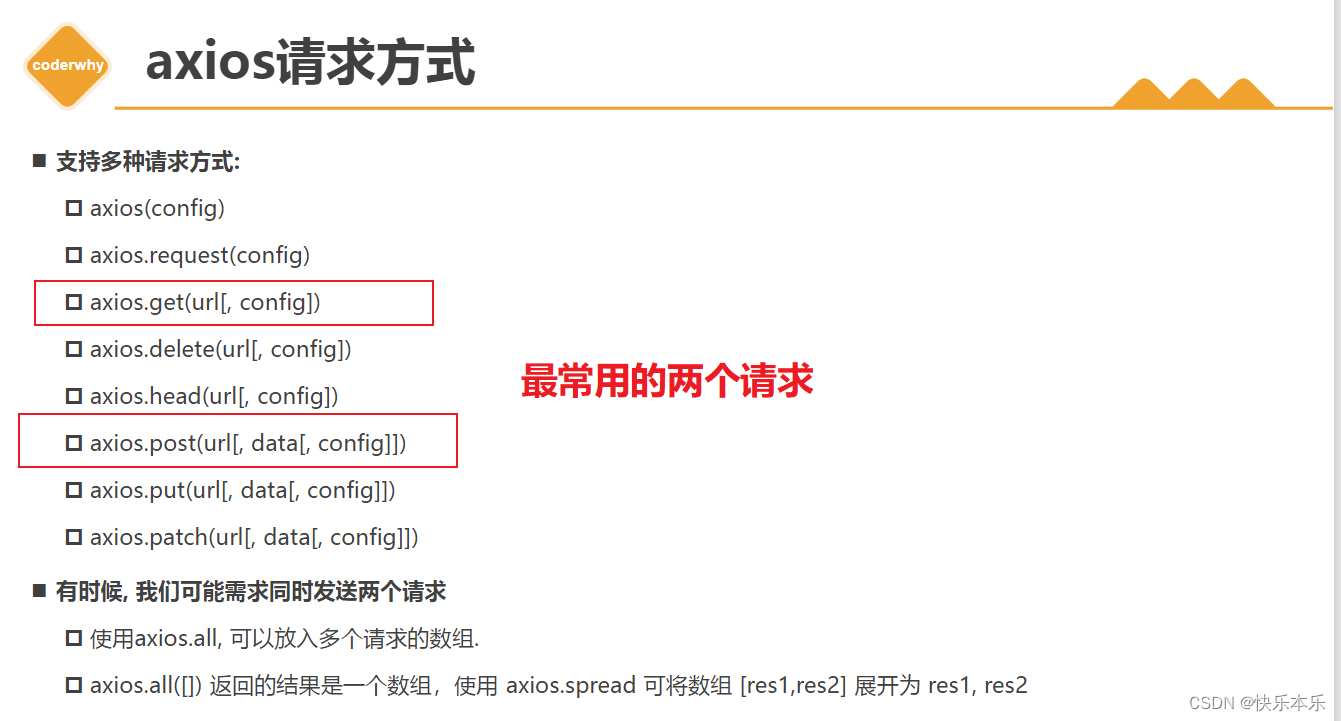
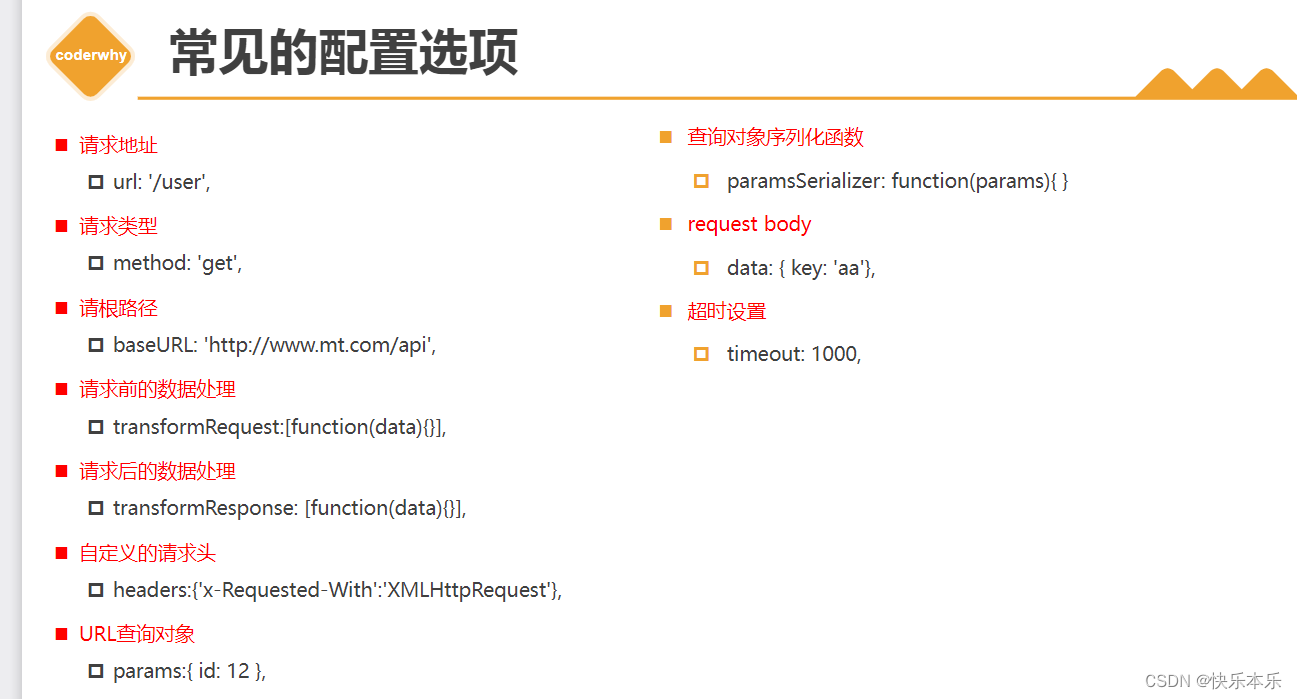
使用Axios
1.安装axios
2.创建service文件夹并在里面创建index.js,import axios,然后创建封装axios的类并导出创建的axios实例对象
3.在main.js在导入封装好的对象即可使用
常见请求演示
get请求有两种写法,一个是直接拼接一个是写参数
pst请求是不可以拼接到url里的,
还有跨域的问题,这个可以好好了解一下
httpbin.org 走get请求测试
// 1.发送request请求
axios.request({
url:"http://123.207.32.32:8000/home/multidata",
method:"get"}).then(res =>{console.log("res:", res.data)//注意一般拿到数据是返回res.data,而不是返回一整个promise对象})// 2.发送get请求 直接拼接
axios.get('your_url').then(response =>{const data = response.data;console.log(data);//这样就可以拿到promise里的数据,都要做这样的一个处理,否则是一个promise对象。})
axios.get(`http://123.207.32.32:9001/lyric?id=500665346`).then(res =>{console.log("res:", res.data.lrc)})// get请求 写参数
axios.get("http://123.207.32.32:9001/lyric",{
params:{
id:500665346}}).then(res =>{console.log("res:", res.data.lrc)})// 3.发送post请求
axios.post("http://123.207.32.32:1888/02_param/postjson",{
name:"coderwhy",
password:123456}).then(res =>{console.log("res", res.data)})// data格式
axios.post("http://123.207.32.32:1888/02_param/postjson",{
data:{
name:"coderwhy",
password:123456}}).then(res =>{console.log("res", res.data)})
配置选项
baseURL+all
// 1.baseURL,很有用,因为大部分前面都是一样的const baseURL ="http://123.207.32.32:8000"// 给axios实例配置公共的基础配置 要在这里配置后才可以使用
axios.defaults.baseURL = baseURL
axios.defaults.timeout =10000
axios.defaults.headers ={}// 1.1.get: /home/multidata
axios.get("/home/multidata").then(res =>{console.log("res:", res.data)})// 1.2.get: /home/data// 2.axios发送多个请求// axios.all:发送多个请求 内部是封装了一下 Promise.all而已
axios.all([
axios.get("/home/multidata"),
axios.get("http://123.207.32.32:9001/lyric?id=500665346")]).then(res =>{console.log("res:", res)//这里返回的也是多个请求的结果})
创建axios实例
创建自己的axios实例
不会用默认的,为每一个url创建一个实例,不同的url对应不同的实例
取决于项目,可能会从多个服务器拿数据,这样有多个实例就更方便
// axios默认库提供给我们的实例对象
axios.get("http://123.207.32.32:9001/lyric?id=500665346")// 创建其他的实例发送网络请求const instance1 = axios.create({
baseURL:"http://123.207.32.32:9001",
timeout:6000,
headers:{}})//创建实例之后就用实例来进行操作
instance1.get("/lyric",{
params:{
id:500665346}}).then(res =>{console.log("res:", res.data)})const instance2 = axios.create({
baseURL:"http://123.207.32.32:8000",
timeout:10000,
headers:{}})
后面可以在封装的Axios类方法里创建多个实例传出去。
请求拦截(掌握)
基本上都会进行拦截,可以对请求做一些处理,比如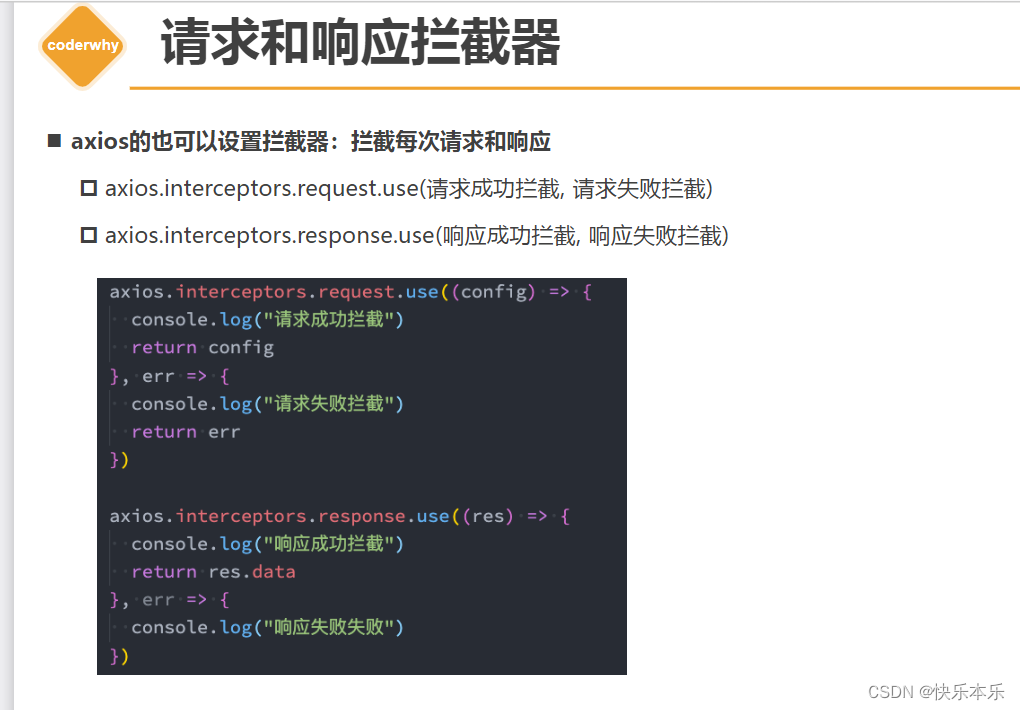
可以在拦截之后做一些配置
拦截后操作:
// 对实例配置拦截器
axios.interceptors.request.use((config)=>{console.log("请求成功的拦截")// 1.开始loading的动画// 2.对原来的配置进行一些修改// 2.1. header// 2.2. 认证登录: token/cookie// 2.3. 请求参数进行某些转化return config
},(err)=>{console.log("请求失败的拦截")return err
})
axios.interceptors.response.use((res)=>{console.log("响应成功的拦截")// 1.结束loading的动画// 2.对数据进行转化, 再返回数据return res.data
},(err)=>{console.log("响应失败的拦截:", err)return err
})
axios.get("http://123.207.32.32:9001/lyric?id=500665346").then(res =>{console.log("res:", res)}).catch(err =>{console.log("err:", err)})
对axios的类的封装(掌握)
用别人的库是有风险的,万一这个库不能用了,项目就会出问题,而且耦合度就太高了,修改很麻烦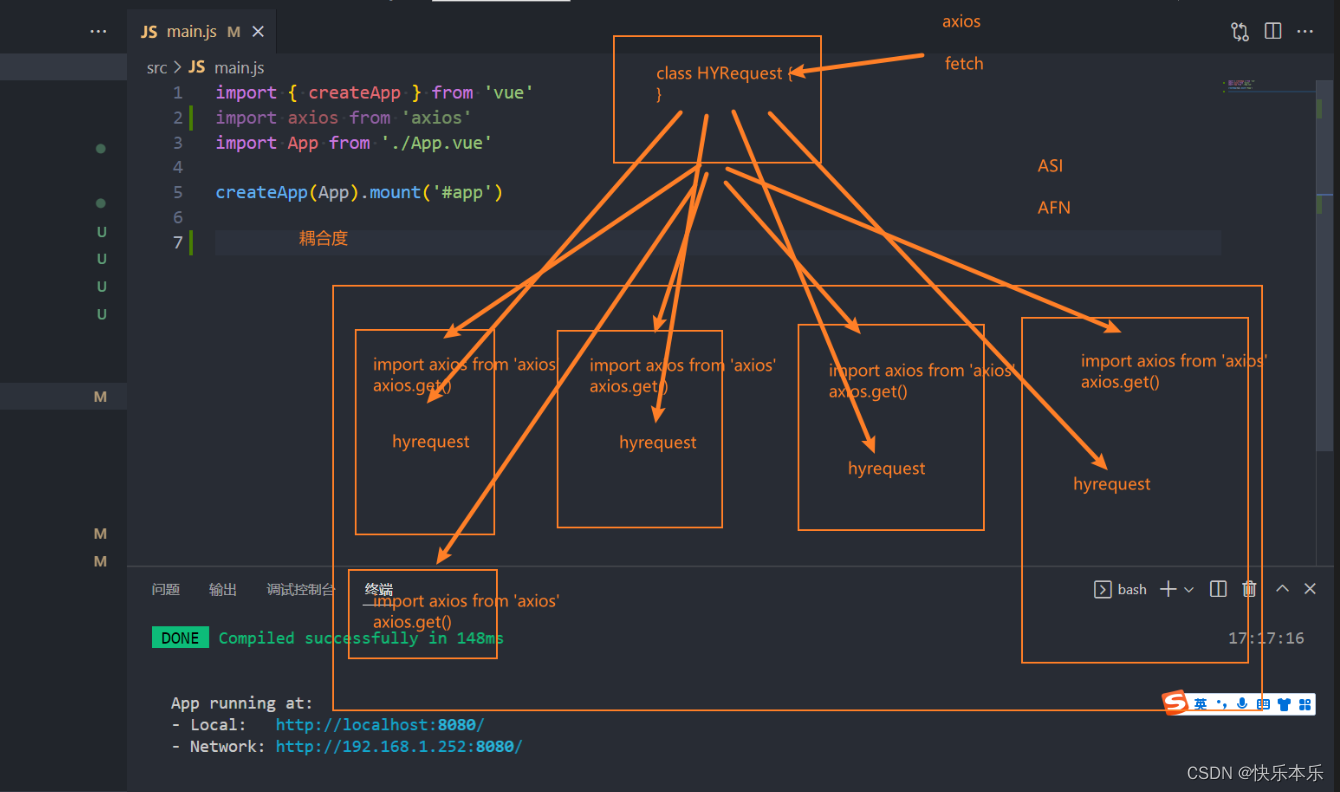
解决办法,对库多封装一层,这样替换这个库的时候就直接在这个封装这里修改就好了,这样就不用全都一个个的修改,这个概念也很简单,这就是封装的好处。
这个思想真的很重要,但是这一步在项目里面就很重要,是很重要的一个思想
这个东西就很好,只有吃过亏才知道,所以这也是听课的好处,不然自己摸索不知道摸索多久
在src里面创建service的文件,用来放封装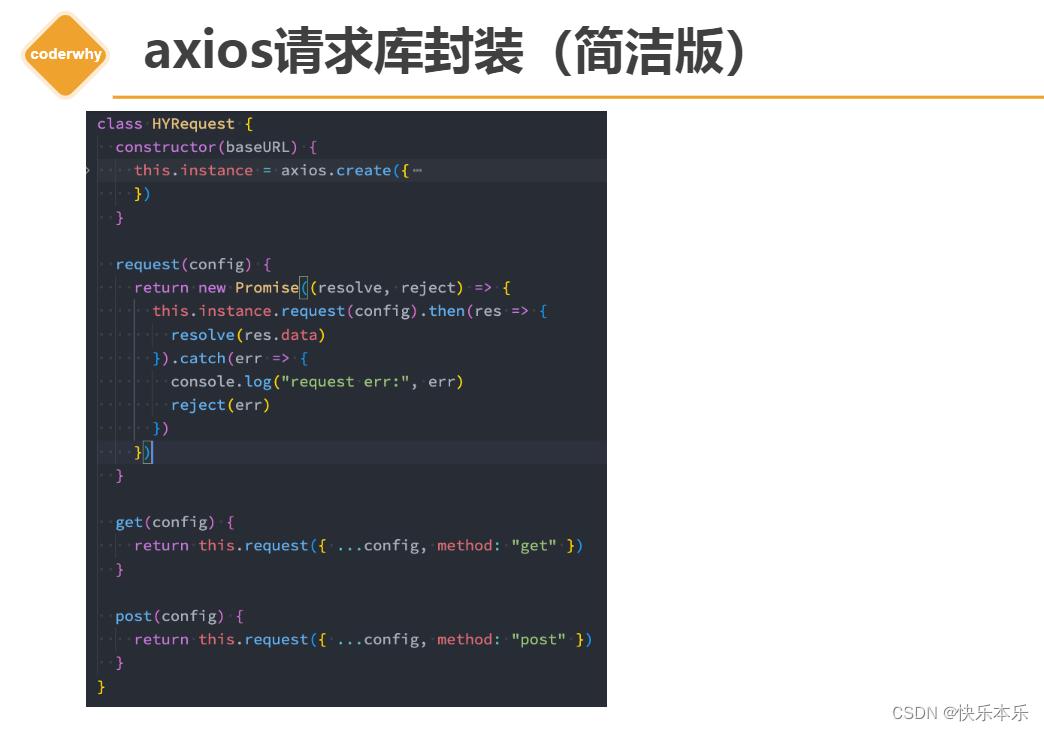
axios请求库封装
封装源码:
import axios from'axios'classHYRequest{constructor(baseURL, timeout=10000){this.instance = axios.create({
baseURL,
timeout
})}//使用this来指向当前创建的实例对象request(config){returnnewPromise((resolve, reject)=>{this.instance.request(config).then(res =>{resolve(res.data)}).catch(err =>{reject(err)})})}get(config){returnthis.request({...config, method:"get"})}post(config){returnthis.request({...config, method:"post"})}//后面也可以在这里创建更多的方法,方式是差不多的}exportdefaultnewHYRequest("http://123.207.32.32:9001")//这里导出的是一个实例对象,然后你也可以创建多个实例对象导出去,这个就是比较简单了

老师封装好的一个更完全的axios库
使用于TS
在项目中用ts封装axios,一次封装整个团队受益😁
import axios,{ AxiosResponse }from'axios'importtype{ AxiosInstance, AxiosRequestConfig }from'axios'importtype{
RequestConfig,
RequestInterceptors,
CancelRequestSource,}from'./types'classRequest{// axios 实例
instance: AxiosInstance
// 拦截器对象
interceptorsObj?: RequestInterceptors<AxiosResponse>/*
存放取消方法的集合
* 在创建请求后将取消请求方法 push 到该集合中
* 封装一个方法,可以取消请求,传入 url: string|string[]
* 在请求之前判断同一URL是否存在,如果存在就取消请求
*/
cancelRequestSourceList?: CancelRequestSource[]/*
存放所有请求URL的集合
* 请求之前需要将url push到该集合中
* 请求完毕后将url从集合中删除
* 添加在发送请求之前完成,删除在响应之后删除
*/
requestUrlList?:string[]constructor(config: RequestConfig){this.requestUrlList =[]this.cancelRequestSourceList =[]this.instance = axios.create(config)this.interceptorsObj = config.interceptors
// 拦截器执行顺序 接口请求 -> 实例请求 -> 全局请求 -> 实例响应 -> 全局响应 -> 接口响应this.instance.interceptors.request.use((res: AxiosRequestConfig)=> res,(err:any)=> err,)// 使用实例拦截器this.instance.interceptors.request.use(this.interceptorsObj?.requestInterceptors,this.interceptorsObj?.requestInterceptorsCatch,)this.instance.interceptors.response.use(this.interceptorsObj?.responseInterceptors,this.interceptorsObj?.responseInterceptorsCatch,)// 全局响应拦截器保证最后执行this.instance.interceptors.response.use(// 因为我们接口的数据都在res.data下,所以我们直接返回res.data(res: AxiosResponse)=>{return res.data
},(err:any)=> err,)}/**
* @description: 获取指定 url 在 cancelRequestSourceList 中的索引
* @param {string} url
* @returns {number} 索引位置
*/privategetSourceIndex(url:string):number{returnthis.cancelRequestSourceList?.findIndex((item: CancelRequestSource)=>{return Object.keys(item)[0]=== url
},)asnumber}/**
* @description: 删除 requestUrlList 和 cancelRequestSourceList
* @param {string} url
* @returns {*}
*/privatedelUrl(url:string){const urlIndex =this.requestUrlList?.findIndex(u => u === url)const sourceIndex =this.getSourceIndex(url)// 删除url和cancel方法
urlIndex !==-1&&this.requestUrlList?.splice(urlIndex asnumber,1)
sourceIndex !==-1&&this.cancelRequestSourceList?.splice(sourceIndex asnumber,1)}request<T>(config: RequestConfig<T>):Promise<T>{returnnewPromise((resolve, reject)=>{// 如果我们为单个请求设置拦截器,这里使用单个请求的拦截器if(config.interceptors?.requestInterceptors){
config = config.interceptors.requestInterceptors(config)}const url = config.url
// url存在保存取消请求方法和当前请求urlif(url){this.requestUrlList?.push(url)// TODO 在axios0.22起,对CancelToken已经弃用,需要改成 AbortController 文档:https://axios-http.com/docs/cancellation
config.cancelToken =newaxios.CancelToken(c =>{this.cancelRequestSourceList?.push({[url]: c,})})}this.instance
.request<any,T>(config).then(res =>{// 如果我们为单个响应设置拦截器,这里使用单个响应的拦截器if(config.interceptors?.responseInterceptors){
res = config.interceptors.responseInterceptors(res)}resolve(res)}).catch((err:any)=>{reject(err)}).finally(()=>{
url &&this.delUrl(url)})})}// 取消请求cancelRequest(url:string|string[]){if(typeof url ==='string'){// 取消单个请求const sourceIndex =this.getSourceIndex(url)
sourceIndex >=0&&this.cancelRequestSourceList?.[sourceIndex][url]()}else{// 存在多个需要取消请求的地址
url.forEach(u =>{const sourceIndex =this.getSourceIndex(u)
sourceIndex >=0&&this.cancelRequestSourceList?.[sourceIndex][u]()})}}// 取消全部请求cancelAllRequest(){this.cancelRequestSourceList?.forEach(source =>{const key = Object.keys(source)[0]
source[key]()})}}exportdefault Request
export{ RequestConfig, RequestInterceptors }
版权归原作者 快乐本乐 所有, 如有侵权,请联系我们删除。